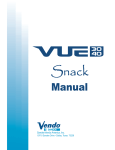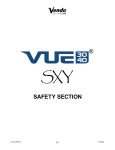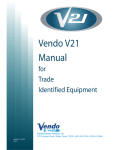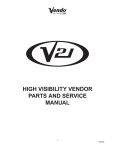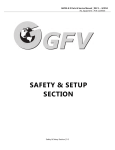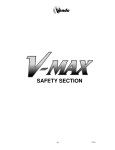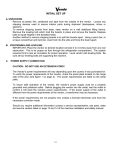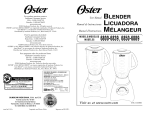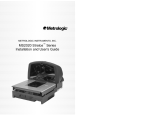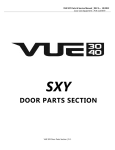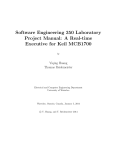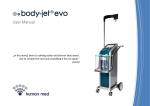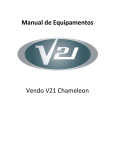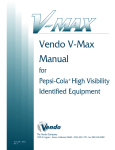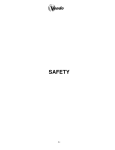Download VSA/SR Glass Front Snack Manual
Transcript
Glass Front Snack Vendor VSA/SR 400 and VSR/SR 500 OPERATIONS MANUAL P/N 1128336-1 1 Contents 1. General Information Page 1.1. 1.2. 1.3. 1.4. 1.5. 1.6. 1.7. 1.8. 1.9. 1.10. 1.11. Introduction....................................................................................................... Machine Specifications..................................................................................... Principle Operation .......................................................................................... Start Up............................................................................................................. Purchase Product............................................................................................. Installation Requirements................................................................................. Filling Operation............................................................................................... Price Label Layout............................................................................................ Routine Maintenance........................................................................................ Troubleshooting................................................................................................ After-Sales Service .......................................................................................... 3 3 4 4 5 5 6 7 8 8 9 2. Safety 2.1. 2.2. 2.3. 2.4. 2.5. 2.6. 2.7. 2.8. 2.9. 2.10. Commitment to Safety...................................................................................... Vendor Installation ........................................................................................... Electrical Hazards............................................................................................. Mechanical Hazards ........................................................................................ Refrigeration Hazards....................................................................................... Temperature Hazards....................................................................................... Substitutions and Modifications........................................................................ Consumer Safety Warning................................................................................ Parts, Sales, and Service Centers.................................................................... Parts, Sales, and Service Centers for Latin America........................................ 11 11 14 16 17 17 17 19 20 21 3. Installation 3.1. 3.2. 3.3. Client Information.............................................................................................. 26 Installation Sequence........................................................................................ 26 Key Operator Training....................................................................................... 26 4. Four-button service mode 4.1. 4.2. 4.3. Entering Service mode.………………………………………………....…………. 28 Exiting service mode......................................................................................... 28 Service mode functions..................................................................................... 27 5. VMC Board................................................................................................................. 40 6. Maintenance 6.1. Chiller Removal..................................................................................................... 6.2. Power Box Removal ............................................................................................. 6.3. Tray Removal........................................................................................................ 6.4. Lock Change/Replacement................................................................................... 6.5. Control Board Replacement.................................................................................. 6.6. Motor Replacement............................................................................................... 6.7. Vend Hopper Replacement................................................................................... 47 47 47 47 47 47 48 Appendix A - Parts Drawings and Descriptions..................................................... 48 Appendix B - Electrical Wiring Diagram................................................................... 68 2 Section 1 1. General information 1.1. Introduction This service manual covers the VSA-XXX and the VSR-XXX Snack Vending Machine. This manual is designed to act as a reference for service technicians. We recommend that you study this manual as there are many features and uses. If you do not understand any part of this manual please contact SandenVendo America Technical Service Department at (800) 344-7216 ext 9934. 1.2. Machine Specifications Product Name Glass Front Snack Vending Machine Product Type VSA-XXX & VSR-XXX Location Environment Inside only Outside size inch (mm) (Length x Width x Depth) 72 x 37 x 28 (1830 x 940 x 720) Weight lbs (kg) Net weight 661.35 (300) Adjustment scope for screw inch (mm) .79 (20) Voltage (v) 115 +10%/-15% Frequency (Hz) 60 Nominal current (A) VSA-XXX (0.6) & VSR-XXX (8.5) Product capacity Followed by owner’s needs (note: for normal product capacity, please see list below) Refrigeration Temperature Environment Temperature ≤ 104°F (40°C), Temperature Inside of machine ≤ 77°F (25°C) Tray position (Black Color) Product tray # of Products per Chute # of Products per Tray A 4 product tray 8 32 B 4 product tray 8 32 C 4 product tray 10 40 D 8 product tray 4(12) + 4(14) 104 E 8 product tray 4(10),12,14,2(28) 122 F 4 product tray 8 32 3 1.3. Principle operation When coins or bills are inserted, the identification system will identify the bills and coins; then the amount of money will appear in the LCD window, press the key pad to choose the goods you want to purchase, then machine will drive the selected products to the vend hopper. If there is still some change left, you can continue purchasing; If you don’t want to purchase anything more, press the coin return button to get the change; if no other products are selected within a 30 second period, then the change will be automatically returned. 1.4. Startup Open the door of the machine, connect the power, and turn on the power switch. Fill coin mechanism with change. According to the filling operation, fill all the products into the trays one by one. According to the price label lay out, install the price label. Set up the machine control system as per the customers’ requirements. Lock the door of the vending machine, the vending machine is ready for use. 4 1.5. Purchase Product Diagram 1 1.6. Installation Requirements 1.6.1. Ensure the machine is level, and adjust the screws on the feet as below (diagram 2). Notice: To adjust the door to ensure that it should automatically stay in any position after opening the door. Diagram 2 5 1.6.2. 1.6.3. 1.6.4. 1.6.5. 1.6.6. Make sure the machine has enough space in the front and at the door axis side to let the door open enough. The distance between the wall and the back of the vending machine should be more than 15cm (5.9 inches) to ensure a good air flow; otherwise the function of chiller will be affected and even can not work properly. Put the machine on a flat and stable ground, prevent water splash on the machine, and avoid leakage that may harm people after raining. Keep away from heat source, avoid the sunshine directly and put in a place where there is good air conditioning and not water. The power supply must be 115V/60Hz and the rated supply current should be more than 16A. The ground wire must connect with ground to prevent shock, at the same time to prevent electromagnetic interference caused by static. All wire connections must be made by a professional electrician; it is forbidden to install by an unprofessional worker. It’s better to set the power outlet into the special power distribution box to prevent people from damaging the plug and avoiding electric shock. 1.7. Filling Operation Open the door in the maximum position, lift up the tray approximately 30mm (1.18 inch), and then pull it out to the stop position. There should be only one tray in the filling products position. When pushing the tray back, it must be pushed back to the original position as shown in (diagram 3). When filling products, don’t force it into the spiral, products should be put freely. If there is not enough space for it to move, it will get jammed, then consumer won’t get the product. Under such instance, choose a bigger pitch spiral for more space. 6 When putting plastic packaged products, we suggest folding the bottom of the product, then putting it into the tray in order to prevent product jamming as shown below (diagram 4). Diagram 4 When filling products, please try to put all products to lean in the same direction. When filling products, please notice the height of the product to avoid jamming between two trays. 1.8. Price Label Layout Put the price label into shelf strip insert as shown (diagram 5). Diagram 5 7 1.9. Routine Maintenance 1.9.1. 1.9.2. 1.9.3. 1.9.4. 1.9.5. 1.9.6. 1.9.7. Use soft cloth dipped in detergent to clean the bill entry chute. This will help to prevent dust from affecting the bill identification mechanism. Use soft cloth dipped in detergent to clean the coin entry chute. This will help to prevent coins from sticking on the chute affecting the normal working process. Ensure the tray, vend hopper, and key pad are clean. Once the power is connected, do not remove the plug, otherwise data will be lost and it will even damage other electric components. Do not place goods around the evaporator in the cabinet, as this will affect the function of the chiller and cause problems. Liquids are to be prohibited from contacting the electrical parts and the mechanism on the Bill Validator or Coin Mechanism. Use soft cloth dipped in detergent to clean the glass and the surface of the machine. 1.10. Troubleshooting Problem Does not accept bills Does not accept coins Incorrect change given Correct change given, but no product was given Have products in the chute, but does not sell Refrigeration Compressor has no refrigerating effect The door can not be locked Products continue to go out Reasons Solution 1. Changer out of change 2. Got dust inside the Bill Validator 3. If money is incorrect 4. If plugs are loose 5. Bill Validator is damaged 1. If change is incorrect 2.Indicator light of Coin Mechanism (CM) is not working (Red Lamp) 3. Coin jam or dust in the CM 4. Jam on electromagnetic distribution brake 5. Red indicator light of CM is shining 6. Water got into CM 7. CM damaged 1. Filling the coins incorrectly 2. Control board didn’t adjust into the correct position for returning change 3. Coin return pole of CM got jam 4. The address of the CM is not correct 5. Label price and setting price are not matched 6. CM is damaged 7. Coin return mechanism is in the wrong position 1. Spiral jamming 2. Spiral didn’t return to the same position 3. Mistakingly chose the empty chute 4. Incorrect product filling 1. Correctly fill up coins 2. Clean up the part of the Bill Validator 3. Use correct money 4. Reinstalling the connector after turning off the power 5. Change to a new one 1. False coin can not be accepted, use correct change 2. Check if the power and plug are loose 3. Open up the machine to clean CM 4. Use small tool to remove the jammed external things 5. Check low level transducer, use Alpha to delete all the faults by adjusting 349 address to 1 6. Take out the CM ,use dryer to dry it 7. Change to a new one 1. After resetting, fill coins correctly 2. Adjust into the correct change status otherwise it will get no change to return or even get less change. 3. Dealing with the part that got jammed, check the reposition status of each coin return pole, (press button MODE twice, each pole return to front automatically) 4. Adjust each position or change 5. Reset price carefully to let them match 6. Change to a new one 7. Check the coin return mechanism position if it is in the correct position 1. Cleanup and reposition it to let the motor turn one cycle 2. Take out the spiral to adjust it to the original position 3. Choose Carefully, if no product in the chute, filled in time or adjust the price of empty chute to “0”or the highest price 4. Choose correct products and can not just place it into the spiral, if zthe dimension of the products is smaller than 2/3 of the spiral diameter, they are not allowed to fill into the spiral, otherwise will get product jam. 1. Continue to insert money until it is enough or more than the product price 2. Change vending motor 1. The price of product is higher than the inserted money 2. Vending motor failure 1. Air flow hatch got jammed 2. The position of thermostat is not correct 3. Low on refrigerant 1. The machine is not leveled. 2. The distance between Lock and Lock socket is long. 1. Selling products mechanism has problems 1. Clean it up, position the rear of the machine 15cm (5.9 inch) from the wall. 2. Adjust the controller into the right position 3. Find professional refrigeration maintenance person to replace or add refrigerant. 1. Level the machine; adjust the screw under the lock one pitch lower than other three screws 2. Loosen the door lock mounting nut, adjusting it up and down until you can close the door easily 1. Check the motor position switch whether it works normally, if it works normally, then it is the control board’s problem, change to a new one. 8 1.11. After-Sales Service 1.11.1. Please read the vending machine manual carefully before using the product and follow the instruction correctly. 1.11.2. The guarantee period for the product: except 3 years guarantee for refrigeration system and chiller, other spare parts have 1-year guarantee. Within guarantee period, if there are any problems caused by quality of manufacture, contact our technical service department to deal with your problems with the receipt. After 1-year guarantee period, we will charge for providing you spare parts. Technical Service Department Phone Number: (800) 3447216 ext. 9934 1.11.3. Training is provided at no cost. 1.11.4. Excluding for guarantee scope: providing frequently exchanged components, any accidents, incorrect use, or any product failures caused by face-lifting or repairs done by a non-authorized person. 9 NOTES 10 Section 2 2. Safety 2.1. A COMMITMENT TO SAFETY SandenVendo America is committed to safety in every aspect of our product design. SandenVendo America is committed to alerting every user to the possible dangers involved in improper handling or maintenance of our equipment. The servicing of any electrical or mechanical device involves potential hazards, both to those servicing the equipment and to users of the equipment. These hazards can arise because of improper maintenance techniques. The purpose of this manual is to alert everyone servicing SandenVendo America equipment of potentially hazardous areas, and to provide basic safety guidelines for proper maintenance. This manual contains various warnings that should be carefully read to minimize the risk of personal injury to service personnel. This manual also contains service information to insure that proper methods are followed to avoid damaging the vendor or making it unsafe. It is also important to understand these warnings are not exhaustive. SandenVendo America could not possibly know, evaluate, or advise of all of the conceivable ways in which service might be done. Nor can SandenVendo American predict all of the possible hazardous results. The safety precautions outlined in this manual provide the basis for an effective safety program. Use these precautions, along with the service manual, when installing or servicing the vendor. We strongly recommend a similar commitment to safety by every servicing organization. Only properly-trained personnel should have access to the interior of the machine. This will minimize the potential hazards that are inherent in electrical and mechanical devices. SandenVendo America has no control over the machine once it leaves the premises. It is the owner or lessor’s responsibility to maintain the vendor in a safe condition. See Section I of this manual for proper installation procedures and refer to the appropriate service manual for recommended maintenance procedures. If you have any questions, please contact the Technical Services Department office in your area. SAFETY RULES Read the Safety Manual before installation or service. Test for proper grounding before installing to reduce the risk of electrical shock and fire. Disconnect power cord from wall outlet or air dam before servicing or clearing product jams. The vending mechanism can trap and pinch hands. Use only fully-trained service technicians for Power-On servicing. Remove any product prior to moving a vendor. Use adequate equipment when moving a vendor. Always wear eye protection, and protect your hands, face, and body when working near the refrigeration system. Use only authorized replacement parts. Be aware of inherent dangers in rocking or tipping a vending machine. 2.2. VENDOR INSTALLATION 2.2.1. Vendors are large, bulky machines of significant size and weight. Improper handling can result in injury. When moving a vendor, carefully plan the route to be taken and the people and equipment required to accomplish the task safely. 2.2.2. Remove all tape, shipping sealant, and Styrofoam from the vendor. Loosen any shipping devices used to secure interior parts during shipping. Remove the wooden shipping base attached to the vendor base by the vendor leveling screws. Make certain the leveling screws are in place and functional. 2.2.3. Position the vendor 15cm (5.9 inches) from a well-constructed wall (of a building or otherwise) on a flat, smooth surface. IMPORTANT: The vendor requires 15cm (5.9 inches) of air space from the wall to ensure proper air circulation to cool the refrigeration unit. 11 2.2.4. 2.2.5. 2.2.6. Adjust the leveling screws to compensate for any irregularities on the floor surface. Ideally, no adjustment will be necessary and the leveling legs will be flush with the bottom of the vendor. A spirit level is a useful aid to level the vendor. When the outer door is open, it will remain stationary if the vendor is properly leveled. Vendors must be level to ensure proper operation and to maintain stability characteristics. Do not add legs to the vendor. The leveling legs shall not raise the vendor more than 1 1/8 inch above the ground. Check the manufacturer’s nameplate on the left or right side of the vendor’s cabinet to verify the main power supply requirements of the vendor. Be sure the main power supply matches the requirements of the vendor. To ensure safe operation, plug the vendor only into a properly grounded outlet. DO NOT USE EXTENSION CORDS. Recommended voltage specs = volts required + amps of circuit. NOTE: Any power supply variance more than + 10% may cause the vendor to malfunction. * Power outlets must be properly grounded. * Power outlets must be properly polarized, where applicable. Test the outlets using the following information. (Refer to Figure 1) For Type 1 and Type 2 outlets, test for Grounding and Polarization as follows: With a test device (volt meter or test light), connect one probe to the receptacle’s neutral contact and the other to the live contact. The test device should show a reaction. 2.2.7.1. Connect one probe to the receptacle’s earth contact and the other to the live contact. The test device should show a reaction. 2.2.7. For Type 3 through Type 5 outlets, test for Grounding as follows: With a test device (volt meter or test light), determine which of the receptacle’s power contacts is the live contact. 2.2.8.1. Connect one probe to the receptacle’s earth contact. 2.2.8.2. Connect the second probe to the left (or upper) power contact. If a reaction occurs, this is the live power contact. If a reaction does not occur, move the second probe to the right (or lower) contact. A reaction should occur, indicating that this is the live power contact. 2.2.9. Connect one probe to the receptacle’s live power contact (as determined in step 1). Connect the second probe to the other power contact (neutral). The test device should show a reaction. 2.2.8. IF THE ABOVE CONDITIONS ARE NOT MET FOR THE GIVEN OUTLET TYPE, CONTACT A LICENSED ELECTRICIAN AND HAVE THE NECESSARY CORRECTIONS MADE. 12 FIGURE 1 13 2.3. ELECTRICAL HAZARDS 2.3.1. General SandenVendo America vending machines are provided with the appropriate power supply setting for your area. Some models are equipped with step-down transformers, as required. This enables the vending machine to operate on different main voltages. Refer to the machine specifications for information to determine the main power requirements. Refer to the appropriate service manual for details of step-down transformer operations. The power sources just mentioned are standard for both household and commercial lighting and appliances. However, careless or improper handling of electrical circuits can result in injury or death. Anyone installing, repairing, loading, opening, or otherwise servicing a vending machine should be alerted to this point. Apply all of the normal precautions observed in handling electrical circuits, such as: Refrigeration servicing to be performed by qualified personnel only. Unplug the vendor or move power switch to off position before servicing or clearing product jams. Replace electrical cords if there is any evidence of fraying or other damage. Keep all protective covers and ground wires in place. Plug equipment into outlets that are properly grounded and polarized (where applicable), and protected with fuses or circuit breakers. All electrical connections must be dry and free of moisture before applying power. 2.3.1.1. Grounding Systems SandenVendo America vending machines are provided with the appropriate service cord for the power supply in your area. The service cord will connect to the matching electrical outlet. Always ensure that the outlet to be used is properly grounded before plugging in the vendor. The electrical grounding system also includes the bonding of all metal components within the vendor. This involves a system of bonding wires identified by green or green and yellow marking. The system uses serrated head screws, lock washers, and star washers to ensure the electrical connection between parts. Maintenance of vending equipment may involve disassembly. Include the above items when reassembling, even if the vending machine may appear to function normally without them. Omitting any of these items can compromise a link in the grounding system. See the appropriate service manual or kit instructions for components and assembly instructions. 2.3.1.2. Servicing with “Power Off” For maximum safety, unplug the service cord from the wall outlet before opening the vendor door. This will remove power from the equipment and avoid electrical and mechanical hazards. Service personnel should remain aware of possible hazards from hot components even though electrical power is off. See the appropriate sections of this manual for further information. 2.3.1.3. Servicing with “Power On” Some service situations may require access with the power on. Power on servicing should be performed only by fully-qualified service technicians. Particular caution is required in servicing assemblies that combine electrical power and mechanical movement. Sudden movement (to escape mechanical action) can result in contact with live circuits and vice versa. It is therefore 14 doubly important to maintain maximum clearances from both moving parts and live circuits when servicing. Power to lighting and refrigeration system is shut off automatically by the electronic controller when the outer door is opened. NOTE: For power-on servicing of the vendor’s lighting system, turn lighting power on by accessing the Lights test function of the electronic controller (see programming on inner door). For power-on servicing of the vendor’s refrigeration system, turn refrigeration power on by accessing the Compressor test function of the electronic controller (see programming on inner door). 15 2.4. MECHANICAL HAZARDS 2.4.1. Servicing of Moving Parts and Assemblies When servicing assemblies involving moving parts, use extreme caution!! Keep finger, hands, loose clothing, hair, tools, or any foreign material clear of entrapment. As noted before under the electrical hazards section, Power On servicing should only be performed by qualified personnel. Refer to and heed the warnings noted in the electrical hazards section. These warnings refer to the potential hazards associated with electrical power and moving parts. Always maintain maximum clearances from electrical and moving parts. Always install protective covers and guards when reassembling equipment. 16 2.5. REFRIGERATION HAZARDS 2.5.1. General Refrigeration systems involve both electrical power and mechanical action. These systems may present any of the potential dangers shown in the sections on electrical and mechanical hazards contained in this manual. See the electrical hazard section and the mechanical hazard section for further information. 2.5.2. Compressed Refrigerant Refrigeration systems involve the compression and evaporation of gases. The pressures contained represent a potential hazard if suddenly released in confined areas. Caution is required when performing maintenance tests or repairs. All testing of sealed refrigeration systems must be done by trained personnel who are familiar with the systems and pressures involved. 2.5.3. Physical Protection The accidental release of refrigerant gases can result in physical injuries. Always wear protective glasses and protect your hands, face, and body when working near the refrigeration system. 2.6. TEMPERATURE HAZARDS 2.6.1. General Maintenance personnel should be alerted to the potential hazards from hot metal surfaces. High temperatures may be present throughout the refrigeration system even though electrical power has been removed. 2.7. SUBSTITUTIONS AND MODIFICATIONS 2.7.1. General Unauthorized changes or the substitution of unauthorized parts can compromise the equipment designs. This can result in unsafe conditions for either the service personnel or the equipment users. Always refer to the appropriate parts and service manual for replacement parts and maintenance instructions. If questions arise, contact the Technical Services Department of SandenVendo America office in your area. When servicing the vending machine, always reassemble all components to their original location and position. Maintain the correct routing for tubing, electrical wiring, etc... Replace all clamps, brackets, and guides to their original locations. Replace all tubing, sleeving, insulating material, and protective covers to their original condition. 2.7.1.1. Service Cord Replacement SandenVendo America vending machines are furnished with unique power supply cords. If replacement becomes necessary, consult the appropriate parts and service manual and order the correct replacement cord for the model of vending machine in question. Do not use substitute replacement cords. Only authorized service personnel with appropriate training should replace the vending machine service cord. If a question should arise concerning which 17 service cord to order, contact the Technical Services Department of the SandenVendo America office in your area. The wires in the main leads are colored in accordance with the following code: 110v/120v 220v/240v Green White Black Green and Yellow........................................ Earth Blue.............................................................. Neutral Brown........................................................... Live 18 2.8. CONSUMER SAFETY WARNING 2.8.1. General There have been incidents, including fatalities, when vending machines have been vandalized by being pulled over in an attempt to obtain free product or money. To warn of the danger involved in tipping, shaking, or rocking the vending machine, a decal has been designed to be affixed to vending machines. (One such decal is applied on the vending machine.) SandenVendo America will supply sufficient decals to be placed on all machines, on request. If you have any questions, contact the Technical Services Department of the SandenVendo America office in your area. THE FOLLOWING DECAL SHOULD BE PLACED IN A POSITION ON THE VENDOR CONTROL PANEL AT EYE LEVEL 19 2.9. PARTS, SALES, and SERVICE CENTERS of SandenVendo/Sanden Company AREA United States, Canada ADDRESS SandenVendo America, Inc. 10710 Sanden Drive Dallas, TX 75238-1335 U.S.A. PHONE NUMBERS Tel: (800) 344-7216 ext. 9934 Fax: (800) 541-5684 Japan Sanden International Corporation 31-7 Taito 1-Chome Taito-ku Tokyo 110, Japan Tel: (81) 3-3835-1321 Fax: (81) 3-3833-7096 Europe, Mid-East Africa, Mid-Asia Vendo GMBH Spangerstr. 22, P.O. Box 130940 40599 Dusseldorf Germany Tel: (49) 211-74-039-0 Fax: (49) 211-7488541 Australia, New Zealand Sanden International Pty. Ltd. 54 Allingham St., Condell Park N.S.W. 2200 Australia Tel: 61-2-9791-0999 Fax: 61-2-9791-9029 Singapore, Hong Kong, Indonesia, Phillippines, India Sanden International (Singapore) Pte., Ltd. Sanden House, 25, Ang Mo Kio St. 65 Singapore 569062 The Republic of Singapore Tel: 65-482-5500 Fax: 65-482-1697 Taiwan Sanden International Taiwan Corp. No, 21-6, Sec 1 Tun Hwa S. Rd., Taipei, Taiwan Taiwan, ROC Tel: 886-2-570-6106 Fax: 886-2-577-1959 Belgium N.V. Vendo Benelux, S.A. Industrial Research Park N.O.H. 13 Font St. Landry 1120 Brussels Belgium Tel: 32-2-268-2595 Fax: 32-2-268-2862 England Vendo UK Ltd. Vendo House Kingsclere Road Basingstoke, Hants RG21, 5GU Great Britian Tel: 44-1256-479309 Fax: 44-1256-844469 Italy Vendo Italy S.p.A. Casella Postale 9 1-15033 Casale Monferrato Italy Tel: 39-142-335111 Fax: 39-142-5623-48 Spain Vendo Iberia, S.A. C/ Sant Ferran No. 92 Poligono Industrial la Almeda, Sector P-1 08940 Cornella, (Barcelona), Spain Tel: 343-474-1555 Fax: 343-474-1842 20 2.10. Parts. Sales, and Service Centers of SandenVendo/Sanden Company for Latin America AREA Mexico ADDRESS Vendo de Mexico Carreta Mexico – Tequisquiapan Km 3.2 San Juan del Rio, Queretaro C.P. 76800 PHONE NUMBERS Tel: (52) 427 2718096 Fax: (52) 427 2718077 Mexico IMI Cornelius de Mexico, S.A. de C.V. Manual Dublan No. 35 Col. Tacubaya, Deleg. Miguel Hidalgo C.P. 11870 Mexico Tel: (52 55) 5272-7904 Fax: (52 55) 5273-5949 Central America SandenVendo America, Inc. 10710 Sanden Drive Dallas, TX 75238-1335 U.S.A. Tel: (800) 344-7216 ext. 9934 Fax:(800) 541-5684 South America SandenVendo America, Inc. 10710 Sanden Drive Dallas, TX 75238-1335 U.S.A. Tel: (800) 344-7216 ext. 9934 Fax:(800) 541-5684 21 NOTES 22 Section 3 3. Installation 3.1. Client Information Checklist Intended machine location Access to machine location Product availability Vend prices Name of key operator and relief key operator What sales audit information (If any) will be required? Availability of client and key operator(s) for demonstration and training. Any special circumstances (e.g. safety requirements) Advise the client of the time taken for installation and the key operator(s) training requirement. Check that the following services are available. Electrical supply mains terminated within 7 feet of the machine by an accessible switched socket of minimum 8 A rating (dependent on country). 3.2. Installation sequence 1) Check for transit damage. 2) Remove the packaging materials from the machine. 3) Remove mains plug cover on rear of machine. 4) Fit rubber ring into mains plug cover. 5) Refit mains plug cover with plug external to the machine. 6) Ensure the machine is fitted on a stable, level surface. 7) Connect the machine to the electrical supply. See Safety Section for power requirements. 8) Check correct operation by performing vend (paid or otherwise). 9) Do not use extension cords. 3.3. Key Operator Training Training Steps Train the key operator and the relief in the operation of the machine, using the operator’s guide as a script. It is in the technician’s interest to ensure that the training is effective otherwise preventable machine breakdowns will occur. 1) Demonstrate a vend cycle. 2) Identify the key components of the machine. 3) Using the operators guide, explain the control board menu functions. 4) Pay particular attention to ensuring that price setting is fully understood. 5) Ensure the key operator is aware of the fault finding section of the guide, and instruct in the repairs possible by the key operator. Demonstration If possible demonstrate to the client that the machine installation is complete and that the key operator has been trained. Confirm that they are satisfied. 23 Section 4 4. Four-button service mode 1 2 3 Clear 4 5 6 Enter 7 8 9 * 0 # Figure 1: Sales Mode Keypad ▲ ▼ Figure 2: Service Mode Keypad Movement in service mode is accomplished through the use of four of the product selection keys on the keypad mounted on the front of the machine. Figure 1 (above) shows the normal, sales mode keypad definitions. When the vendor is placed in service mode, the definition of the product selection keys change and assumes the definitions shown in Figure 2 (above). All service mode functions adhere to a four-button service mode scheme as defined in the table below: Key Key 2 = ▲ Key 3 = ▼ Key 4 = Enter Definition This key is used to increase a numeric value, or move forward through the various service mode functions. This key is used to decrease a numeric value or move backwards through the various service mode functions. This key is used to confirm, accept, or enter into a service mode function This key is used to exit or leave a service mode function Key 1 = Clear/Exit 4.1. Entering service mode: To enter into service mode open the vendor door and press the yellow mode switch. The switch is located near the bottom edge of the e controller. After pressing the mode switch the controller will beep twice and the display will change to show stored errors. If no errors have occurred, the display will show “no errors”. At this time you can use the keypad on the front of the machine to move through the various service mode functions. 4.2. Exiting service mode: The controller will remain in service mode and long as the user keeps using the keypad to move through the various service mode functions. The controller will automatically exit service mode and return to sales mode if any of the following occur: 1) The user is inactive for more than 3 minutes 2) The vendor door is closed 24 3) The user navigates to the “Return” service mode option and presses the “4” (Enter) key When service mode is exited the beeper will sound twice and the installed firmware version will be shown on the display for three seconds, then the controller will revert to sales mode. 4.3. Service mode functions: The table below is a summary list of the service mode functions. Each service mode function is described in detail in its respective section. Function Description Section Errors Coin Insert/ Dispense Cash Accountability Sales Accountability Set Price Diagnostics Options Set time and date Override Sales blocking 1 Sales blocking 2 Return Allows errors to be viewed and cleared Allows coins to be inserted or dispensed Allows the user to view cash sales data Allows the user to view product sales data Allows the prices to be changed Allows the user to perform various tests Allows the user to configure vend options Allows the user to set the time and date Allows the user to setup overrides Allows the user to setup primary sales blocking Allows the user to setup secondary sales blocking Exit from service mode 4.3.1 4.3.2 4.3.3 4.3.4 4.3.5 4.3.6 4.3.7 4.3.8 4.3.9 4.3.10 4.3.11 4.3.12 4.3.1. Errors: 4.3.1.1. Accessing reported errors: Errors: The controller constantly monitors its peripheral devices (refrigeration, AC Power, coin mech., bill validator, etc) and records failures or out of tolerance conditions. These errors can be viewed by accessing the errors menu in service mode. The errors menu is the first service mode function in service mode. As such, it will always appear as the first menu item upon entry into service mode. No Errors: If there are no errors to report when service mode is entered, the display will show the message “No Errors”. In this case, where there are no recorded errors and presses of the “4” (Enter) key will be ignored. If there are recorded errors to report, the display will show the message “Errors Were Detected”. To view the errors, press the “4” (Enter) key. The first stored error will appear on the display. Errors are grouped into categories, such as “Refrigeration Error” or “Vending Error”. In most cases, you will first see the error category when you press the “4” (Enter) key. To view the errors within the category, press the “4” (Enter) a second time and the display should now show the specific error details. Errors Were Detected: If the controller has recorded multiple errors within in a single category, you can use the up and down keys to cycle through the errors. If the errors occur multiple categories, use the “*” (Clear) key to reach to the category level and then use the up down keys to cycle through the various error categories. As before, use the “4” (Enter) key to enter into the category and view the specific errors. 25 4.3.1.2. Clearing reported errors: To clear an error, press and hold the “4” (Enter) key while the specific error is shown on the display. The display should remove the error and then display either the next error category, or the “No Errors” message. In some cases, reported errors may immediately re-appear after they have been cleared. This usually indicates that the condition that originally spawned the error still exists and even though the error has been cleared, the condition has not been corrected. Therefore the controller finds, and reports the same error over and over again. For example, if the controller reports a “Refrigeration” / “Too Hot” error, this error can not be successfully cleared until the vendor temperature cools enough to reach the temperature set point and is no longer “Too Hot”. Some errors are transitory, and are only displayed as long as the error condition persists. An example of this is the “Coin Communications” error. This error is reported whenever the coin mechanism (if connected at power up) is no longer communicating. If communications are restored, the error is automatically cleared. If communications are interrupted when service mode is entered, this error will be reported. 4.3.2. Coin Insert / Dispense: The coin insert / dispense service mode function allows the user to manually insert or dispense coins from the coin mechanism. This is generally regarded as the best way to insert or remove coins from a coin mechanism because it allows the controller to maintain accurate counts of the coin tube inventory. Coin Insert/Dispense To access this function, enter service mode and use the “2”or “3”(▲or▼) keys to navigate to the “Coin Insert / Dispense” menu item and then press the “4” (Enter) key. The display should now change to show the lowest denomination coin type (in the U.S. this will be 0.05) and the number of that specific coin type that the controller believes that the coin mech. has in its tubes. 4.3.2.1. Dispensing Coins: To dispense a coin, use the or “3”(▲or▼) keys to select the coin type that you would like to dispense and press the “4” (Enter) key. The coin mech. should pay out a single coin of the selected type. Subsequent presses of the “4” (Enter) key will dispense more coins of the selected type. You can use thee “2”or “3”(▲or▼) keys at any time to select a different coin type for dispense. As before, pressing the “4” (Enter) key will dispense the selected coin. As coins are dispensed, you should see the inventory level (as reported by the display) decrease with each coin dispensed. In some cases such as under low tube inventory conditions, the coin inventory may not decrease with every coin. Most coin mechanisms “hide” a few coins from the controller. This is done to increase the mass of coins at the bottom of the coin tubes to increase the reliability of coin payout. The controller is aware of this and uses a complex algorithm to keep track of coin tube inventory. 26 4.3.2.2. Inserting Coins: When the controller is first placed in service mode, coin and bill acceptance are disabled. When the controller is placed in “Coin Insert / Dispense” mode coin acceptance is automatically enabled. You can insert coins into the coin mechanism and they should be accepted and routed to the coin tubes. In addition, the type and number of the coin(s) of the most recently inserted coin type will be shown on the display. Please note that the coin insert function is intended to be used for filling the coin tubes, thus non-tube coins (coins for which there are no coin tubes) will be rejected. In the US, the dollar coin is usually a non-tube coin and as such, will not be enabled for acceptance. 4.3.3. Cash Accountability The controller keeps a running count of all transactions generates a cash sales report. This report can be viewed from within the cash accountability section of service mode. An exhaustive report, perhaps more than you may care to know, is available as an electronic “flat” file through the DEX interface. Please refer to the DEX portion of this manual for details on DEX. Cash Accountability Cash accountability data is stored as both resettable (interval sales) and non-resettable (never cleared) totals. The cash accountability function shows the non-resettable totals for all selections, and the resettable totals for each individual selection. To access the Cash Accountability information, press the “4” (Enter) key while the “Cash Accountability” menu item is shown on the display. You can use the “2”or “3”(▲or▼) keys to sequence through the various service mode functions until the Cash Accountability menu item appears. The first total you will see when you enter Cash Accountability is the cumulative nonresettable cash total. This total represents the total amount of cash (coins and bills) that has been received by the machine since the controller was first created. To view cash sales by selection use the “2”or “3”(▲or▼) keys to sequence through the various selections. The corresponding resettable sales total for that selection will be shown on the display. 4.3.4. Sales Accountability The controller keeps a running count of all transactions generates a sales report. This report can be viewed from within the sales accountability section of service mode. An exhaustive report, perhaps more than you may care to know, is available as an electronic “flat” file through the DEX interface. Please refer to the DEX portion of this manual for details on DEX. Sales Accountability Sales accountability data is stored as both resettable (interval sales) and non-resettable (never cleared) totals. The sales accountability function shows the non-resettable totals for all selections, and the resettable totals for each individual selection. To access the Sales Accountability information, press the “4” (Enter) key while the “Sales Accountability” menu item is shown on the display. You can use the “2”or “3”(▲or▼) keys to sequence through the various service mode functions until the Cash Accountability menu item appears. The first total you will see when you enter Sales Accountability is the cumulative nonresettable sales total. This total represents the total number of vends that have been made by the machine since the controller was first created. 27 To view sales by selection, use the “2”or “3”(▲ or ▼) keys to sequence through the various selections. The corresponding resettable sales total for that selection will be shown on the display. 4.3.5. Set Price The controller allows the user to set the price by individual selection, row of selections, or all selections simultaneously. To access “Set Price Mode” use the “2” or “3”(▲ or ▼) keys to sequence through the various menu items until the “Set Price” menu item is shown on the display and then press the “4” (Enter) key. Set Price Upon entry into set price mode you will be presented with a list of options for setting prices. The first menu item is “Set Price by Selection”. You can use the”2” or “3”(▲or▼) keys to sequence through the other price setting options. These are “Set Price By Row” and “Set All Prices”. You can press the “4” (Enter) key to enter into a particular price setting mode. Please note that the price increment will be controlled by the scale factor of the coin mechanism that is installed on the controller. In the US, the price should change by a $0.05 increment. If you are unable to enter into set price mode there is probably a problem with the coin mechanism, or coin mechanism harness. 4.3.5.1. Set price by selection: To set a price for an individual selection enter into “Set Price by Selection” and use the “2” or “3”(▲or▼) keys to sequence through the various selections. When the selection you wish to change is shown in the display, press the “4” (Enter) key. The display will now show the chosen selection and the current price for the increase or decrease the price. When you are satisfied with the new price press the “4” (Enter) key and the new price will be saved. If you are dissatisfied with the changes, press the “*” (Clear) key and the changes will be aborted. 4.3.5.2. Set price by row To set a price for an entire row of selections enter into “Set Price by Row” and use the “2” or “3”(▲or▼) keys to sequence through the various rows. When the row you wish to change is shown in the display, press the “4” (Enter) key. The display will now show the row number and the current price for the left most selection in the row. You can use the”2” or “3”(▲or▼) keys increase or decrease the price. When you are satisfied with the new row price, press the “4” (Enter) key and the new price will be saved for all selections within the given row. If you are dissatisfied with the changes, press the “*” (Clear) key and the changes will be aborted. 4.3.5.3. Set all prices To set the same price for every selection in the machine, enter into “Set All Prices”. The display should now show the current price for the selection in the upper left corner of the machine (A1). Use the”2” or “3”(▲or▼) keys increase or decrease the price. When you are satisfied with the new price, press the “4” (Enter) key and the new price will be saved for all selections in the machine. If you are dissatisfied with the changes, press the “*” (Clear) key and the changes will be aborted. 4.3.6. Diagnostics The Diagnostics function allows the user to test many of the devices connected to the controller. This may be useful in identifying and correcting a reported problem. Many of the normal precautions for operating a device, such as refrigeration timeout, are over-ridden in diagnostics mode. Therefore care should be taken not to damage peripheral devices through indiscriminate use or fast switching. Diagnostics: 28 To enter into Diagnostics mode use the “2” or “3”(▲or▼) keys to sequence through the various service mode functions until the “Diagnostics” message is shown on the display and press the “4” (Enter) key. The diagnostics menu contains the menu items shown in the table below. Each menu item is discussed in greater details later in this section: Test vend Test display Display RTC Test keypad Test relays Display AC level Test switches Test delivery detection Display software rev Test bill validator Test temp sensors The first menu item you will encounter in the Diagnostics menu is the “Test Vending” menu. You can use the “2”or “3”(▲or▼) keys to sequence through the various menu items within the diagnostics menu and press “4” (Enter) when the item of interest is shown on the display. 4.3.6.1. Diagnostics: Test Vending The Diagnostics Test Vending feature can be used to perform a test vend by selection, by row, or every selection in the vendor. This feature is typically used to verify the proper operation of a motor or home vend motors. To access the test vend menu use the 8” or “3”(▲ or ▼) keys to sequence through the various menu items within Diagnostics until the “Diagnostics / Test Vending” menu is shown on the display and press the “4” (Enter) key. Diagnostics Test Vending 4.3.6.2. Diagnostics: Test Vending one selection at a time The first menu item you will encounter in the Test Vending Test Vending menu is “One Selection Only”. One Selection Only As the name suggests, this menu is used to test a single selection at a time. To enter into this menu press the “4” (Enter) key and the display will now show “Test Vending / Selection: A1”. This is the left most selection in the top tray. You can use the 8” or “3”(▲ or ▼) keys to sequence through the other selections in the vendor. When you are satisfied with your selection press the “4” enter key and the selected vend motor should run and stop at its home position. If there is an error running the motor the controller will report the error before returning to the menu. You can repeat this test as needed. 4.3.6.3. Diagnostics: Test Vending one selection with delivery detection The second menu in test vending is “One Test Vending with Detection”. In some instances you may One With Detection want to test vend the motor and the delivery detection. To enter into this menu press the “4” (Enter) key and the display will now show “Test Vending / Selection: A1”. This is the left most selection in the top tray. You can use the 8” or “3”(▲or▼) keys to sequence through the other selections in the vendor. When you are satisfied with your selection press the “4” enter key and the selected vend motor should run and stop at its home position. If a product passes through the delivery detection system the message “Pass” should appear on the display. If there is an error running the motor, or a product does not occlude the detection system then the controller will report the error before returning to the menu. 29 4.3.6.4. Diagnostics: Test Vending an entire row of selections The third menu in test vending is “Vend Test Vending Entire Row”. This menu item allows the user to test every selection within a given Vend Entire Row row. To enter into this menu press the “4” (Enter) key and the display will now show “Test Vending / Vend Entire Row / Row A”. The “Row A” is the alpha letter associated with the top tray in the vendor. You can use the “2”or “3”(▲or▼) keys to sequence through the other rows. When you are satisfied with your selection press the “4” enter key and the selected vend motor should run and stop at it’s home position. If a product passes through the delivery detection system the message “Pass” should appear on the display. The third menu in test vending is “Vend Entire Row”. This menu item allows you to test 4.3.6.5. Diagnostics: Test Vending every selection in the vendor The last menu item in the Test Vending Test Vending menu is “Vend Every Selection”. This menu item allows the user to test every motor in Vend Every Selection the vendor in sequence. To enter into this menu press the “4” (Enter) key and the display will now show “Test Vending / Selection A1”. The “Selection A1” is the first selection to be vended. This is updated to the current selection as each motor is test vended. You can use the “*” (Clear) key to abort the test if needed. As each motor is successfully vended the message “Pass” will appear on the display after the selection ID. 4.3.6.6. Test Keypad The test keypad feature is used to test all of the keys on the keypad. This may be helpful in finding a bad key if the location reports a problem, or a defective keypad row or column if selection is not vending as expected. To enter into this feature press the “4” (Enter) key when the message “Test Keypad” is shown on the display. The display will show the message “Test Keypad / Pressed Key #”, where the key that was last pressed in the “4” (Enter) key. You can press any key on the keypad and the “Pressed Key” should update and show the key that was pressed. When you are done you can press and hold the “*” (Clear) key to about keypad test mode. Diagnostics Test Keypad 4.3.6.7. Test Display The Test Display feature is used to test all of the pixels on the display. This may be helpful in testing the display if the location reports a problem with missing characters or pixels. To enter into Test Display press the “4” (Enter) key when the message “Test Display” is shown on the display. The display will show then go through a series of test patterns which among other things, blank all pixels, activate all pixels, test all numbers and letters. When you are done you can press the “*” (Clear) key and the display test will be aborted. Diagnostics Test Display 4.3.6.8. Test Relays The Test Relays feature allows the user to test the relays used by the controller. This may be helpful in determining if the relays are operating properly and diagnosing problems with refrigeration. To enter into Test Relay mode, press the “4” (Enter) key when the message “Test Relays” is shown on the display. The display will show then show the message “Test Relays / Refrigeration Off” where the “Off” is the current state of the relay. You can use the “4” (Enter) key to toggle the relay on and off and use the “2”or “3”(▲or▼) keys to sequence through the list of available relays. When you are done you can press the Diagnostics Test Relays 30 “*” (Clear) key and the relay test will be aborted and the relays will return to their normal state. 4.3.6.9. Test Delivery Detection The Test Detection feature allows the user to test the operation of the delivery detection system. This may be useful if the location is reporting detection errors or if the vendor is not canceling credit after a vend. To enter into Test Detection mode, press the “4” (Enter) key when the message “Test Detection” is shown on the display. The display will show then show the message “Test Detection / Detection Clear” where the “Clear” is the current state of the detection field. If you pass your hand through the detection field the “Blocked” message will appear on the display. When you are done you can press the “*” (Clear) key to exit Test Detection. Diagnostics Test Detection 4.3.6.10. Test Temperature Sensors The Test Temperature Sensors feature allows the user to test (by viewing the current temperature reported by) the refrigeration control and health safety temperature sensors. This may be useful if the location has reported high or low product temperatures, or a Health Safety error. To enter into Test Temp Sensors mode, press the “4” (Enter) key when the message “Test Temp Sensors” is shown on the display. The display will show then show the temperatures reported by each of the sensors. You may notice some nominal offset in temperature between the two sensors, this is usually real, and due to local differences in temperature. When you are done you can press the “*” (Clear) key to exit Test Temp. Sensors. Diagnostics Test Temp Sensors 4.3.6.11. Test AC Volts The Display AC Volts feature allows the user to display the AC voltage at the location. This may be useful in diagnosing a power related problem, which can be pronounced if there are other machines or loads on the same branch circuit. It should be noted that AC Volts is an interpolated measurement based upon the DC voltage seen by the controller. The accuracy of this measurement will be less than 5% and scaled for a 120VAC circuit. To view the AC Voltage press the “4” (Enter) key when the message “Display AC Volts” is shown on the display. The display will then show the current AC voltage. If you suspect that the circuit is overloaded, you may want to watch the voltage over time. Refrigeration systems on nearby vending machines may draw down the AC power especially at start-up. When you are done you can press the “*” (Clear) key to exit Display AC Volts. Diagnostics Display AC Volts 4.3.6.12. Display Time and Date The “Display Time And Date” feature allows the user to display the current time and date information reported by the Real Time Clock. This will allow the user to verify that the clock has been set, and is keeping accurate time. To view the current RTC time, press the “4” (Enter) key when the message “Display Time And Date” is shown on the display. The display will then show the current time and date. When you are done you can press the “*” (Clear) key to exit Display RTC Data. Diagnostics Display Time and Date 31 4.3.7. Options Menu The options menu contains a collection of on/off software “switches” that allow the user to change various parameters on the vendor. This allows the operator to configure the vendor for company preference, local conditions, and/or accepted practices. The options menu contains 10 programmable options, which can be enabled (on) or disabled (off) from within the options menu. To enter into the Options menu use the “2”or “3”(▲or▼) keys to sequence through service mode until the Options menu appears on the display then press the “4” (Enter) key. The table below is a summary of the option available in this menu. Each item is explained in detain in the corresponding section. Options Option Default State Preferred State Section 1 Single Price Off 4.3.7.1 2 Multi Vend Off 4.3.7.2 3 Forced Vend Off 4.3.7.3 4 Free Vend Off 4.3.7.4 5 Bill Escrow On 4.3.7.5 6 Delivery Detection On 4.3.7.6 7 No Cheat On 4.3.7.7 8 POS Disable Off 4.3.7.8 4.3.7.1. Single Price The single price option allows the user to set the vend price for every selection to the same price. The state of this option will have an influence on what options are available in the set price menu. The single price option may be useful if the machine is vending the same product from all locations, or if every selection has the same value and sales price. The current state of this option is shown on the display when entering into the options menu. If you wish to change the setting, press the “4” key. The state (On or Off) will begin to blink and you can now use the “2”or “3”(▲or▼) keys to toggle the state from on to off or off to on. When you are satisfied with the state of this option, press the “4” (Enter) key to save the changes. If you are not satisfied with your changes you can press the “*” (Clear) key to abort option setting without making changes. Options Single Price: OFF 4.3.7.2. Multi Vend The Multi vend option allows the vendor to hold change due after a purchase to allow the customer to make a second purchase without re-inserting coins. This may be helpful in generating a second sale, but because this is not a standard practice, the use of multi-vend may lead to operator confusion. The current state of the multi-vend option is shown on the display when entering into the options menu. If you wish to change the setting, press the “4” (Enter) key. The state (On or Off) will begin to blink and you can now use the “2”or “3”(▲or▼) keys to toggle the state on or off. If you are satisfied with the state of this Options Multi Vend: OFF 32 option, press the “4” (Enter) key to save the changes. If you are not satisfied with your changes you can press the “*” (Clear) key to abort option setting without making changes. 4.3.7.3. Forced Vend The Forced vend option is used to “force” the customer to use inserted bill and nonyube credit towards the purchase of a product. Forced vend is normally used to keep customers from using the vendor as a change machine thereby depleting the coin tube inventory. This is a common problem Laundromats when a bill changer runs out of coins or is out of service. The current state of the forced-vend option is shown on the display when entering into the options menu. If you wish to change the setting, press the “4” (Enter) key. The state (On or Off) will begin to blink and you can now use the “2”or “3”(▲or▼) keys to toggle the state on or off. If you are satisfied with the state of this option, press the “4” (Enter) key to save the changes. If you are not satisfied with your changes you can press the “*” (Clear) key to abort option setting without making changes. Options Forced Vend: OFF 4.3.7.4. Free Vend The Free vend option (as the name implies) is used to put the vendor into free vend mode. In this mode credit acceptance is inhibited and every selection is available free of charge. This feature may be useful for product demonstrations, or where the location sponsors vending as an employee benefit, or to distribute personal protective gear and/or job related paraphernalia. The current state of the free-vend option is shown on the display when entering into the options menu. If you wish to change the setting, press the “4” (Enter) key. The state (On or Off) will begin to blink and you can now use the “2”or “3”(▲or▼) keys to toggle the state on or off. If you are satisfied with the state of this option, press the “4” (Enter) key to save the changes. If you are not satisfied with your changes you can press the “*” (Clear) key to abort option setting without making changes. Options Free Vend: OFF 4.3.7.5. Bill Escrow The Bill Escrow option is used to control whether or not bills will be stacked upon receipt. Under normal conditions, the controller will escrow the last bill accepted unless the highest price in the vendor is greater than the face value of the bill. Some operators prefer to escrow, rather than stack, bills because it allows the vendor to return the customer’s bill instead of the equivalent change. The current state of the bill escrow option is shown on the display when entering into the options menu. If you wish to change the setting, press the “4” (Enter) key. The state (On or Off) will begin to blink and you can now use the “2”or “3”(▲ or ▼) keys to toggle the state on or off. If you are satisfied with the state of this option, press the “4” (Enter) key to save the changes. If you are not satisfied with your changes you can press the “*” (Clear) key to abort option setting without making changes Options Bill Escrow: ON 4.3.7.6. Delivery Detection The Delivery Detection option is used to control whether or not the delivery detection system will be used to determine if a vend was successful. The current state of the delivery detection option is shown on the display when entering into the options menu. If you wish to change the setting, press the “4” (Enter) key. The state (On or Off) will begin to blink and you can now use the “2”or “3”(▲or▼) keys to toggle the state on or off. If you are satisfied with the state of this option, press the “4” (Enter) key to save the changes. If you are Options Delivery Detection: ON 33 not satisfied with your changes you can press the “*” (Clear) key to abort option setting without making changes 4.3.7.7. No Cheat The No Cheat option is used to control whether or not the vendor will be allowed to perform a vend in which the customer’s credit may be at risk. Under certain conditions, such as exact change, the vendor can not guarantee that proper change will be dispensed after a vend, or in the event of a vend failure. If No Cheat is enabled, the vendor will return all credit and cancel a vend if it cannot verify that proper credit cannot be paid back. If No Cheat is disabled, the controller will always make a “good faith” attempt to pay back proper change after a vend, but will not require that this can be done prior to making a vend. The current state of the No Cheat option is shown on the display when entering into the options menu. If you wish to change the setting, press the “4” (Enter) key. The state (On or Off) will begin to blink and you can now use the “2”or “3”(▲or▼) keys to toggle the state on or off. If you are satisfied with the state of this option, press the “4” (Enter) key to save the changes. If you are not satisfied with your changes you can press the “*” (Clear) key to abort option setting without making changes. Options No Cheat: ON 4.3.7.8. POS Disable The POS (Point Of Sale) disable option is used enable or disable the display of the POS Message. The POS message is an idle display message that is used to encourage impulse buys. Some locations, such as where the message may be inappropriate, may prefer that the message be disabled. The current state of the POS Disable option is shown on the display when entering into the options menu. If you wish to change the setting, press the “4” (Enter) key. The state (On or Off) will begin to blink and you can now use the “2”or “3”(▲ or ▼) keys to toggle the state on or off. If you are satisfied with the state of this option, press the “4” (Enter) key to save the changes. If you are not satisfied with your changes you can press the “*” (Clear) key to abort option setting without making changes. Options POS Disable: ON 4.3.8. Set Time and Date The controller uses time and date information to control various events, such sales blocking and the display of time and date information. The time and date menu are used to set the correct time and date and setup clock parameters such as daylight savings and time display options. Set Time and Date POS (Point Of Sale) disable option is used enable or disable the display of the POS Message. The POS message is an idle display message that is used to encourage impulse buys. Some locations, such as where the message may be inappropriate, may prefer that the message be disabled. The current state of the POS Disable option is shown on the display when entering into the options menu. If you wish to change the setting, press the “4” (Enter) key. The state (On or Off) will begin to blink and you can now use the “2”or “3”(▲or▼) keys to toggle the state on or off. If you are satisfied with the state of this option, press the “4” (Enter) key to save the changes. If you are not satisfied with your changes you can press the “*” (Clear) key to abort option setting without making changes. 4.3.9. Overrides Overrides Overrides are used to temporarily bypass or override the state of a controller setting, such as sales blocking or price. The controller is equipped with an override switch. The behavior 34 of the override switch is defined by the settings in the override menu. To enter into the overrides menu, press the “4” (Enter) key while the Overrides message is shown on the display. The first menu Overrides are used to temporarily bypass or override the state of a controller setting, such as sales blocking or price. The controller is equipped with an override switch. The behavior of the override switch is defined by the settings in the override menu. To enter into the overrides menu, press the “4” (Enter) key while the Overrides message is shown on the display. The current (physical) state of the override switch can be viewed in the diagnostics menu (section 2.XXX). Overrides Set Days Option is shown on the display when entering into the options menu. If you wish to change the setting, press the “4” (Enter) key. The state (On or Off) will begin to blink and you can now use the “2”or “3”(▲ or ▼) keys to toggle the state on or off. If you are satisfied with the state of this option, press the “4” (Enter) key to save the changes. If you are not satisfied with your changes you can press the “*” (Clear) key to abort option setting without making changes. 4.3.10. Sales Blocking 1 Sales blocking allows the user to block sales of some or all selections based on the time of day, or and day of week. This is often used when vending machines are deployed at schools to prevent students from purchasing items that are high in caffeine or sugar during normal school hours. To enter into the Sales Blocking 1 menu, press the “4” (Enter) key while the Sales Blocking 1 message is shown on the display. Sales Blocking 1 Sales blocking allows the user to block sales of some or all selections based on the time of day, or and day of week. This is often used when vending machines are deployed at schools to prevent students from purchasing items that are high in caffeine or sugar during normal school hours. To enter into the Sales Blocking 1 menu, press the “4” (Enter) key while the Sales Blocking 1 message is shown on the display. Sales Blocking 1 Set Days The POS (Point Of Sale) disable option is used enable or disable the display of the POS Message. The POS message is an idle display message that is used to encourage impulse buys. Some locations, such as where the message may be inappropriate, may prefer that the message be disabled. The current state of the POS Disable option is shown on the display when entering into the options menu. If you wish to change the setting, press the “4” (Enter) key. The state (On or Off) will begin to blink and you can now use the “2”or “3”(▲ or ▼) keys to toggle the state on or off. If you are satisfied with the state of this option, press the “4” (Enter) key to save the changes. If you are not satisfied with your changes you can press the “*” (Clear) key to abort option setting without making changes. 4.3.11. Sales Blocking 2 Sales blocking allows the user to block sales of some or all selections based on the time of day, or and day of week. This is often used at schools to prevent students from purchasing items high in caffeine or sugar content during normal school hours. Sales Blocking 2 To enter into sales blocking 2, press the “4” (Enter) key when “Sales Blocking 2” is shown on the display. The first menu item from within Sales blocking is “Enable Blocking 1” followed by the current (on or off) state of Blocking 1 4.3.11.1. Blocking 1 Enable 35 Enable Blocking is used to determine if the settings in the Blocking 2 menu will be enforced. If Enable Blocking 2 is set to ON, the settings will be enforced. If Enable Blocking 2 is set to OFF, the settings will be ignored. To change the state of the Blocking enable, press the “4” (Enter) key while the Enable blocking menu item appears on the display. The current state, (on or off), will begin to blink. You can use the “2”or “3”(▲or▼) keys to toggle the state on or off. If you are satisfied with the state of blocking you can press the “4” (Enter) key to save your changes. You can press the “*” (Clear) key at any time to abort the changes. Enable Blocking 2 = OFF 4.3.11.2. Blocking 1 start time Start Time The start time is used to set the time of day and days of the week that blocking 1 should be started. To enter into this menu, press the “4” (Enter) key while the “Start time” message is shown on the display. 4.3.11.3. Blocking 1 Start Time The first menu item in the start time menu is the “Start Day”. This is used to select the days of the week that blocking will be started. To edit the days of the week, press the “4” (Enter) key while the “Start Day” is shown on the display. The display should now show the current day of the week followed by the text: “ON” or “OFF”. The “ON” indicates that blocking is associated with the given day and “OFF” indicates that blocking is not associated with the given day. Start Time Start Day You can use the “2”or “3”(▲or▼) keys to cycle through the various days of the week. Each day will be followed by either ON or OFF. If you wish to change the ON/OFF state, press the “4” (Enter) key while the day you wish to change is shown on the display. The ON/OFF status will now begin to blink. You can use the “2”or “3”(▲or▼) keys to toggle the state from ON to OFF. When you are satisfied with your changes, press the “4” (Enter) key. If you are dissatisfied with the changes you can press the “*” (Clear) key and abort the changes. 4.3.11.4. Blocking 1 Start Time The second menu item in the start time menu is the “Start Hour”. This is used to select the hour that blocking will begin. To view the start hour, press the “4” (Enter) key while the “Start Hour” is shown on the display. The display should now show the current start time for blocking. To edit the start hour, press the “4” (Enter) key while the start hour is shown on the display. Start Time Start Hour You can use the “2”or “3”(▲or▼) keys to change the start hour. When you are satisfied with your changes, press the “4” (Enter) key. If you are dissatisfied with the changes you can press the “*” (Clear) key and abort the changes. 4.3.11.5. Blocking 1 Stop Time The first menu item in the stop time menu is the “Stop Day”. This is used to select the days of the week that blocking will be started. To edit the days of the week, press the “4” (Enter) key while the “Stop Day” is shown on the display. The display should now show the current day of the week followed by the text: “ON” or “OFF”. The “ON” indicates that blocking is associated with the given day and “OFF” indicates that blocking is not associated with the given day. Stop Time Stop Day 36 You can use the “2”or “3”(▲or▼) keys to cycle through the various days of the week. Each day will be followed by either ON or OFF. If you wish to change the ON/OFF state, press the “4” (Enter) key while the day you wish to change is shown on the display. The ON/OFF status will now begin to blink. You can use the “2”or “3”(▲or▼) keys to toggle the state from ON to OFF. When you are satisfied with your changes, press the “4” (Enter) key. If you are dissatisfied with the changes you can press the “*” (Clear) key and abort the changes. 4.3.11.6. Blocking 1 Stop Time The second menu item in the start time menu is the “Stop Hour”. This is used to select the hour that blocking will begin. To view the stop hour, press the “4” (Enter) key while the “Stop Hour” is shown on the display. The display should now show the current start time for blocking. To edit the start hour, press the “4” (Enter) key while the start hour is shown on the display. Stop Time Stop Hour You can use the “2”or “3”(▲or▼) keys to change the stop hour. When you are satisfied with your changes, press the “4” (Enter) key. If you are dissatisfied with the changes you can press the “*” (Clear) key and abort the changes. 4.3.11.7. Blocking 1 Selections The second menu item in the start time menu is the “Stop Hour”. This is used to select the hour that blocking will begin. To view the stop hour, press the “4” (Enter) key while the “Stop Hour” is shown on the display. The display should now show the current start time for blocking. To edit the start hour, press the “4” (Enter) key while the start hour is shown on the display. Selections You can use the “2”or “3”(▲or▼) keys to change the stop hour. When you are satisfied with your changes, press the “4” (Enter) key. If you are dissatisfied with the changes you can press the “*” (Clear) key and abort the changes. 4.3.12. Return Return is the last item in the service mode menu and is used to place the controller back in sales mode. To return to sales mode, press the “4” (Enter) key while the “Return” menu item is shown on the display. You can use the “2”or “3”(▲or▼) keys to move through the service mode menu until the Return message is on the display. To re-enter service mode, press the yellow mode switch. Return 37 NOTES 38 Section 5 5. VMC Board 39 MODE SWITCH 5.1. Connectors In order to assure consistent switch/sensor interfacing, the following descriptions have been defined for use throughout this section. “Dry switch” input to the VMC is defined as: • Normally open, Active closed • Open = > 1 M ohm, Closed = < 1 ohm • Must switch at least 6 VDC • Closed current: min 1 mA, max 100 mA • a push button switch, an active semiconductor device (FET, transistor, etc.), etc. “Open collector” output from the VMC is defined as: • 24 VDC, regulated ± 5% • On = 100 mA max, Off < 100 uA JP1: Executive Interface • • .156” ctr, .025” sq. straight pins, polarized 5 pos AMP P/N 640445-5 # 1 2 3 4 5 Description Executive TXD + Key Executive TXD Executive RXD + Executive RXD - Function O/P Comments O/P I/P I/P 40 JP2: DEX/UCS • • .250” stereo phone plug 3 pos. Neutrik P/N: NRJ6HF-1 # Tip Ring Sleeve Description VMC DEX transmit VMC DEX receive VMC DEX common Function O/P I/P return Comments TTL/RS-232 TTL/RS-232 JP3: Display • • • .100” ctr, .025” sq. straight pins, polarized header 4 pos AMP P/N: 640456-4 SPI data interface for 2 by 20 character VFD. # 1 2 3 4 Description Vcc Clock Serial Data Power and signal common Function Power O/P O/P return Comments 5 VDC, 500 mA JP4: Temperature Sensor • • • .100” ctr, .025” sq. straight pins 10 pos AMP P/N: 1-640456-0 Temp sensor is linearly scaled at 10mV / °F (per degree Fahrenheit) # 1 2 3 4 5 6 7 8 9 10 Description Vcc Key Primary temp signal Power and signal common Key Vcc Key Secondary temp signal Power and signal common Sensor shield Function Power Comments 5 VDC, 500 mA I/P return Power O/P I/P return return 5 VDC, 500 mA 41 JP5: Delivery Detection • • • .100” ctr, .025” sq. straight pins, polarized header 6 pos AMP P/N: 640456-6 Delivery signal is quiescently high and driven low momentarily when blocked # 1 2 3 4 5 6 Description Vcc Delivery detection power Delivery detection signal in Key Delivery detection enable Power and signal common Function Power Power I/P Comments 5 VDC, 500 mA 8 VDC, 500 mA dry switch O/P return dry switch JP6: Selection switches • • .100” ctr, .025” sq. straight pins, polarized header 11 pos AMP P/N: 1-640456-1 # 1 2 3 4 5 6 7 8 9 10 11 Description Selection row 1 Selection row 2 Selection row 3 Selection row 4 Selection row 5 Selection row 6 Key Selection Column 1 Selection Column 2 Selection Column 3 Selection Column 4 Function source source source source source source Comments dry switch dry switch dry switch dry switch dry switch dry switch sink sink sink sink dry switch dry switch dry switch dry switch JP7: Talk Box • • • • DB9 Male right angle 9 pos. AMP P/N: XXXX Talk box signals are wired –or with DEX/UCS signals When enabled, VMC will transmit serial data to talk box # 1 2 3 4 5 6 7 8 9 Description No connection Talk box transmit Talk box receive No connection No connection Talk box common No connection No connection No connection Function Comments I/P I/P TTL/RS-232 TTL/RS-232 return 42 JP8: MDB • • • Mini-Fit Jr. right angle 9 pos. Molex P/N: 39-30-1060 Locking male header # 1 2 3 4 5 6 Description 34VDC power 34 VDC return No connection VMC Receive data VMC Transmit data VMC data common Function Power Return Comments I/P O/P return MDB/RS-232 MDB/RS-232 JP9: Vend Motors • • .156” ctr, .025” sq. straight pins 17 pos Support Versatile, Mars, and CoinCo style motors # 1 2 3 4 5 6 7 8 9 10 11 12 13 14 15 16 17 Description Motor column 1 Motor column 2 Motor column 3 Motor column 4 Motor column 5 Motor column 6 Motor column 7 Motor column 8 Motor column 9 Motor column 10 Key Motor row A Motor row B Motor row C Motor row D Motor row E Motor row F Function sink sink sink sink sink sink sink sink sink sink Comments 400 mA max. 400 mA max. 400 mA max. 400 mA max. 400 mA max. 400 mA max. 400 mA max. 400 mA max. 400 mA max. 400 mA max. source source source source source source 24 VDC @ 400mA 24 VDC @ 400mA 24 VDC @ 400mA 24 VDC @ 400mA 24 VDC @ 400mA 24 VDC @ 400mA 43 JP10: Refrigeration Control • • • .156” ctr, .045” sq. straight pins, polarized header 8 pos AMP P/N 640456-8 Override is active when 7 and 8 are shorted # 1 2 3 4 5 6 7 8 Description Relay power Power and signal common Key Compressor Relay power Spare relay Power and signal common Override switch Function source return Comments 24VDC, ± 5% sink source sink return I/P Open collector 24VDC, ± 5% Open collector JP11: Door Switch • • • .100” ctr, .025” sq. straight pins, polarized header 2 pos AMP P/N: 640456-2 When the door is open, the switch contacts are closed # 1 2 Description Door switch signal Door switch common Function I/P return Comments TTL/RS-232 JP12: DEX/UCS • • • • .100” ctr, .025” sq. straight pins, polarized header 4 pos AMP P/N: 640456-4 Optional PCB mount (JP8) may be loaded in addition to standard header. DEX TXD signal uses “power stealing” from DCE RXD signal to emulate line levels # 1 2 3 4 Description VMC DEX common VMC DEX receive Key VMC DEX transmit Function return I/P Comments O/P TTL/RS-232 TTL/RS-232 JP13: Power • • .156” ctr, .045” sq. straight pins, polarized header AMP P/N 640445-4 # 1 2 3 4 Description Hot Neutral Key Earth ground 4 pos Function power power Comments 24 VAC, 3.3 A 24 VAC, 3.3 A return 44 JP14: Optional motor rows • • .156” ctr, .025” sq. straight pins 2 pos AMP P/N 640445-2 # 1 2 Description Motor row G Motor row H Function source source Comments 24 VDC @ 400mA. 24 VDC @ 400mA 45 NOTES Section 6 46 6. Maintenance It is important to ensure that the chiller vents are cleaned whenever a service engineer visits a machine. This function is easily performed by removing the front chiller cover panel inside the machine, and cleaning the floor vent and chiller grill. 6.1. Chiller removal The chiller is a self enclosed unit which can be easily removed and exchanged. To remove the chiller: Disconnect machine from power supply (either disconnect mains plug or internal IEC power connector). Disconnect IEC chiller connector from power box. Remove the 4 screws retaining the chiller cover panel, and remove panel. Loosen screws on left and right side chiller retaining brackets. The brackets can then be lifted and removed. The chiller unit can now be slid forward and removed from the machine. Re-fitting of the chiller is the reverse of this process. NOTE: The chiller unit is heavy and precautions must be taken when lifting or moving the unit. 6.2. Power box removal The Power Box contains the following electrical components. Lighting Ballast, Mains Filter, Transformer, Interlock Switch, Mains and Chiller IEC Sockets, Fuses. To Remove the Power Box Disconnect both IEC power cables from the front of the Power Box. Remove the four retaining screws fron the Power Box. The Power Box should be slid forward using the handle and removed from the machine. Two looms at the rear of the Power Box need to be diconnected to remove the Power Box entirely from the machine. Re-fitting the Power Box is the reverse of this process. Take care to avoid trapping the two internal looms when inserting the Power Box into the machine. 6.3. Tray removal To remove the tray, first disconnect the relevant tray power cable from the connection panel to the right of the trays. The cable should be pulled through and placed on top of the tray. Pull the tray towards you as performed when loading the tray. At the trays maximum position lift the front edge of the tray to 45 degrees above horizontal and pull the tray towards you. As it comes forward, be careful to support the back of the tray. NOTE: Trays can be heavy and you are advised to first remove all products from the spirals. 6.4. Lock Change/Replacement It is possible to replace the barrel lock for most standard lock types. To do this simply unlock the door, pull the T-handle to its furthest extent and use a tool to release the lock pip from the T-handle (on the outside of the T-handle barrel). To replace the T-handle assembly, remove the nuts from the inside of the door. 6.5. Control board replacement The control board is held in place with 4 PCB mounting posts. All the looms which connect to the board are unique and keyed to ease identification. Please see the Electrical Wiring Diagram for further guidance. 6.6. Motor Replacement All motors are identical and can be used in any spiral (with the exception of the double product spiral motor which vends every 180 degrees). To replace a motor, first remove the tray as described previously. Disconnect the motor loom at the rear of the motor. The motor assembly and spiral can be lifted from the tray. The spiral mounting clip can be removed from the motor housing by compressing the clips at the rear and pushing the mounting clip forward through the motor housing. When replacing the spiral ensure that the end of the spiral is in the appropriate position for the product being vended. 47 6.7. Vend Hopper Replacement The vend hopper and vend flap is a single unit which can be replaced. To remove the hopper Open machine main door. Remove the 2 screws at each end of the hopper which attach the hopper bracket to the door (total of 4 screws to remove). The hopper will now lift away from the door. Replacing the vend hopper is the reverse of this process. To adjust the vend flap height/alignment loosen the bolts at each end of the hopper which support the hopper deflectors. The hopper deflectors and vend flap can then be raised or lowered independently of the hopper itself. 48 NOTES 49 APPENDIX A - PARTS DRAWINGS AND DESCRIPTIONS DESCRIPTION PAGES DOOR ASSEMBLY PG 52 FOOT ROLLER ASSEMBLY PG 53 LAMPASSEMBLY PG 54 VEND HOPPER ASSEMBLY PG 55 KEYPAD ASSEMBLY PG 56 COIN ENTRY & RETURN MECHANISM PS 57 LOCK ASSEMBLY PG 58 CABINETASSEMBLY PG 59 PRODUCT TRAY ASSEMBLY - CHEWING GUM PG 60 PRODUCT TRAY ASSEMBLY – 5 PRODUCTS PG 61 LEFT & RIGHT RUNNER ASSEMBLY PG 62 POWER BOX ASSEMBLY PG 63 REFRIGERATION ASSEMBLY PG 64 HARNESSES PG 65 50 51 DOOR ASSEMBLY ITEM 1 2 3 4 5 6 7 8 9 10 11 12 13 14 15 16 17 18 19 20 21 22 23 24 25 26 27 28 29 30 31 32 DESCRIPTION DOOR WELD CONTROL PANEL MEMBRANE SWITCH ASSEMBLY LOCK ASSEMBLY DOOR GUARD TOP HINGE ASSEMBLY BUSHING-HINGE PLATE UPPER DOOR HINGE ROLLER ASSEMBLY LIGHT ASSEMBLY DBV PLATE BILL VALIDATOR PLUG COIN MECH GUIDE COINAGE MOUNTING BRACKET COIN ENTRY ASSEMBLY COIN CHUTE COIN CHUTE RETURN COINBOX BKT,CONTROL BOARD CONTROL BD,MCS 1080 RAIN CURTAIN DOOR SWITCH ASSEMBLY SLIDER BAR ASSEMBLY RIGHT SIDE HOPPER DEFLECTOR 120V BALLAST ASSEMBLY PRODUCT HOPPER LEFT SIDE HOPPER DEFLECTOR HINGE SIDE PANEL GLASS SIDE GLASS RETAINER TOP/BOT GLASS RETAINER UNIV ASY,CAM BKT QTY SNACK VUE30 SNACK VUE40 1 1 1 1 1 1 2 1 1 1 1 1 2 1 1 1 1 1 1 1 1 1 1 1 1 1 1 1 1 2 2 1 1172505 1156638 1133445 (PG56) 1125552 (PG58) 1125660 1153406 388094 388443 1133482-7 1127649 1146839 1144522 1153376 1156615 1133626 1153535 1153558 1130789 1155099 1155064 1123064 1155786 1153523 1172621 1144522 1172542 1172621-1 1170065 1142536-1 1153418 1153418-2 1156044 1172451 1156638 1133445 (PG56) 1125552 (PG58) 1125660 1153406 388094 388443 1133482-7 1127649 1146839 1144522 1153376 1156615 1133626 1153535 1153558 1130789 1155099 1155064 1123064 1155786 1153523 1172621 1144522 1172542 1172621-1 1168379 1142536 1153418 1153818-1 1156044 52 FOOT ROLLER ASSEMBLY ITEM 1 2 3 4 5 DESCRIPTION RAMP, DOOR ROLLER BRACKET, ROLLER SCREW 1/4-20 X 1 ¾ HX THD CUT SCREW #10 TAPPING – TYPE A QTY 1 1 1 1 2 PART NO. 1130868 1120388 1130432 V802162 V802141 53 LAMP ASSEMBLY ITEM DESCRIPTION 1 2 3 4 5 6 7 LAMP HOLDER TIE WRAP RT-350 LAMP, 2FT,T-8,17W LAMP LENS LAMP HOLDER, .591 RT LAMP HOLDER, .591 LH SCREW, #6-32 X .25 TRUSS HEAD QTY PART NO. 1 3 1 1 1 1 2 1127650 342469-1 1130637 1125967 1126146 1126145 V802243 54 VEND HOPPER ASSEMBLY ITEM 1 2 3 4 5 6 7 8 9 10 11 12 13 DESCRIPTION HOPPER WELD ASY DOOR WELD ASY, FRONT DOOR WELD ASY, REAR LINK, PRODUCT HOPPER SHOULDER WASHER NYLOCK NUT, ¼-20 SHOULDER WASHER, DOOR PIVOT ROD, .312 DIA. EMITTER PCB RECEIVER PCB PUSH-ON LOCK, .312 DIA. SCREW, #8-10 X 3/8” LG FOAM TAPE, VINYL 3/16 X 3/8 QTY SNACK VUE 30 SNACK VUE 40 1 1 1 2 4 4 4 2 1 1 4 2 1 1168696 1154114 1154125 1154175 1154216 387925 1154205 1154198 1128562 1128562-1 1154228 V802294 14563 1168696 1154114 1154125 1154175 1154216 387925 1154205 1154198 1128562 1128562-1 1154228 V802294 14563 55 KEYPAD ASSEMBLY ITEM DESCRIPTION 1 2 3 4 BACKING PLATE MEMBRANE SWITCH MEMBRANE COVER RIVET 1/8" STL. POP .063-.125 QTY PART NO. 1 1 1 2 1131035 1127318 1128798 V801412 56 COIN ENTRY & RETURN MECHANISM ITEM 1 2 3 4 5 6 7 DESCRIPTION COIN CHUTE BODY DISPLAY, 2X20 SERIAL (LED) BRACKET, COIN INSERT SUPPORT COIN CHUTE ASY LEVER,SCAVENGER ASY BUTTON, COIN RETURN SCREW, #8-10 X ½” LG QTY 1 1 1 1 1 1 5 PART NO. 1125367 1121184 1130509 1133638 1133652 1050473 V802214 57 LOCK ASSEMBLY ITEM 1 2 3 4 5 6 7 8 9 10 11 12 13 DESCRIPTION T-HANDLE, LOCK ASY SPRING, COMPRESSION PIN LOCK STUD, LOCK ASY E-CLIP ½” WASHER, HEX LOCK HOUSING, T-HANDLE LOCK CRANK NYLON NUT ½”-20 SHOULDER SPACER, LOCK CAM 3/8” PLAIN FLAT WASHER WASHER, 13/64 SCREW #10-32 X .375, CR PH QTY 1 1 1 1 2 1 1 1 1 1 1 1 1 PART NO. 1076856 387598 387601 1125554 388589 387600 1002384 1126584 1124565 1124527 V801491 389026 V800128 58 CABINET ASSEMBLY ITEM DESCRIPTION QTY SNACK VUE30 SNACK VUE40 1 CABINET FOAM 41.5",BK 1 1126048 1132968 2 PNL,SCRN,REAR 1 1146906 1146906 3 LATCH BRACKET,CAB 3 1172104 1172104 4 W/A,LWR HINGE CAB BASE 1 1155245 1155234 5 GUARD,CAB BASE 1 1167739 1167739 6 RAMP,DOOR 1 1130868 1130868 7 REFER DECK RAMP-LEFT 1 1130467 1130467 8 RAMP,MID-RH,REFER DK 1 1130479 1130479 9 BACK,STOP,REFER 1 1128652 1128652 10 PWR PNL ASY 1 1153511 1153546 11 GUIDE RAIL,WELD ASY,RT * 1168332 1168332 12 GUIDE RAIL,WELD ASY,LT * 1168322-1 1168322-1 13 TRAY ASY,8 OR 10 COLUMN * 1155271 1155271 14 TRAY ASY,4 OR 5 COLUMN * 1155166 1155166 15 ASY,CAB BASE COVER 1 1139733 1132775 59 PRODUCT TRAY ASSEMBLY - CHEWING GUM ITEM 1 2 3 4 5 6 7 8 9 10 11 12 13 14 DESCRIPTION TRAY WLD/RVT ASY, 8 OR 10 COL SHAFT,ROLLER TRAY ASY ROLLER,TRAY ASY NUT,NYLOCK,THIN,6MM EXTR,TRAY,FNT,WIDE EXTR,TRAY,CLIP SPCR SPACER PROD,NARROW COL SCREW 8-10X1/2 CR PH T25 ZI DIVIDER,GUM/MINT NARROW PUSHER,SMALL HELIX VEND HELIX,NARROW COL,19 PROD SPACER,NYLON COUPLING,HELIX,ADJUSTABLE VEND MTR,SNACK,360 ROTATION QTY * * * * * * * * * * * * * * SNACK VUE30 1153819 1154745 1154734 V802235 1152487-1 1152499 1152505 V802214 1152695 1154795 1152452-2 1152701 1152575 1152464 SNACK VUE40 1152683 1154745 1154734 V802235 1152487 1152499 1152505 V802214 1152695 1154795 1152452-2 1152701 1152575 1152464 60 PRODUCT TRAY ASSEMBLY - 5 PRODUCTS ITEM 1 2 3 4 5 6 7 8 9 10 DESCRIPTION WELDED TRAY ASY, 4 OR 5 COLUMN SPACER ASY WIDE COLUMN HELIX GUIDE, WIDE COLUMN MOTOR, 360 DEG. COUPLING, HELIX/MOTOR HELIX, LARGE DIA, 11 PRODUCTS EXTRUSION, FRONT TRAY NYLOCK NUT, 6MM ROLLER ROLLER SHAFT QTY 1 * * * * * 1 2 2 2 SNACK VUE30 1153807 1152736 1154821 1152464 1152575 1152438 1152487-1 V802235 1154734 1154745 SNACK VUE40 1152634 1152736 1154821 1152464 1152575 1152438 1152487 V802235 1154734 1154745 61 LEFT & RIGHT RUNNER ASSEMBLY ITEM 1 2 3 4 5 DESCRIPTION GUIDE RIAL WELDED ASY RIGHT GUIDE RIAL WELDED ASY LEFT NYLON NUT – 6MM ROLLER WHEEL ROLLER SHAFT QTY 1 1 1 1 1 PART NO. 1168332 1168332-1 V802235 1154734 1154745 62 POWER PANEL ASSEMBLY ITEM 1 2 3 4 5 6 7 8 9 DESCRIPTION PWR DIST COVER PNL TRANSFORMER,115/24 VAC RELAY,NAISJM1AN-ZTM-DC24V-F SCREW, #10-16 X 5/16 TYPE B CR HEX FUSE HOLDER HOUSING FUSE,0.8A/250V,3AG SLO-BLOW P-CLIP .25 DIA. HARNESS, POWER DISTRIBUTION SCREW #6-32 3/8 CR PH NUT #6-32 HEX STL QTY 1 1 1 7 1 1 1 1 2 4 SNACK VUE30 1153493 1111201 1128801 V801421 387966 1053864 324099-9 1156925 V800331 V800891 SNACK VUE40 1153304 1111201 1128801 V801421 387966 1053864 324099-9 1156925 V800331 V800891 63 REFRIGERATION ASSEMBLY ITEM 1 2 3 4 5 DESCRIPTION REFRIGERATION UNIT ASSEMBLY, 115V REFRIGERATION UNIT ASSEMBLY, 230V FAN MOTOR, 115V FAN MOTOR, 230V FAN ASY, EVAPORATOR, 115V FAN ASY, EVAPORATOR, 230V TEMPERATURE SENSOR GASKET, REFER QTY PART NO. 1 1 1 1 1033131-267 1033131-268 1127974 1127974-1 1126260 1127994 1122924 1127565 1 1 1 64 HARNESSES ITEM 1 2 3 4 5 6 7 8 9 DESCRIPTION SNACK VUE30 SNACK VUE40 OPTICS VEND DETECT HARNESS TRAY MOTOR HARNESS MAIN HARNESS DOOR HARNESS MAIN POWER CABLE TRAY – 8 or 10 PRODUCTS HARNESS TRAY - 4 or 5 PRODUCTS HARNESS POWER OPTIC BOARD POWER DIST. HARNESS 1154023 1153297 (6 shelf) 1154321 1154319 1168514 1153285 (8 Col.) 1153274 (4 Col.) 1154435 1156925 1154023 1153297 (6 shelf) 1154321 1154319 1168514 1152839 (10 Col.) 1152827 (5 Col.) 1154435 1156925 65 APPENDIX B – ELECTRICAL WIRING DIAGRAM 66 Recommended Spare Parts Part Number 1160939 1154795 1169785 1153523 1156615 390326 1170892 1127318 1144508 1155064 1130789 1126607 1130637 1154734 1154745 V802235 1053864 1128801 1111201 1142536-1 1142536 1152464 1152464-1 1152499 1152575 1152575 1168514 Description Product Pusher Large Product Pusher Small Vend detect optics Latch Bar Assembly Coinage Mtg Bkt Assembly Spring, Coin Return 2 x 20 VF Display Selection Keypad Ballast (120V/60Hz) VMC Board Coin Box Door Switch Lamp 24” T-8 Guide Roller Roller Shaft Nut Fuse 0.8 Amp SB Relay Transformer Glass, Vue 30 Glass, Vue 40 Motor 360o Motor 180 o Candy Spacer Retainer Candy Spacer Coupling Spiral/Motor Power Cord Qty / 10 units AR AR 1 1 1 1 1 1 1 1 1 1 5 5 5 5 5 2 1 1 - AR 1 - AR 5 1 AR AR 5 1 Ref. Pages 60 55 51 57 56 51 54 62 63 51 61 60 65 67 NOTES 68




































































